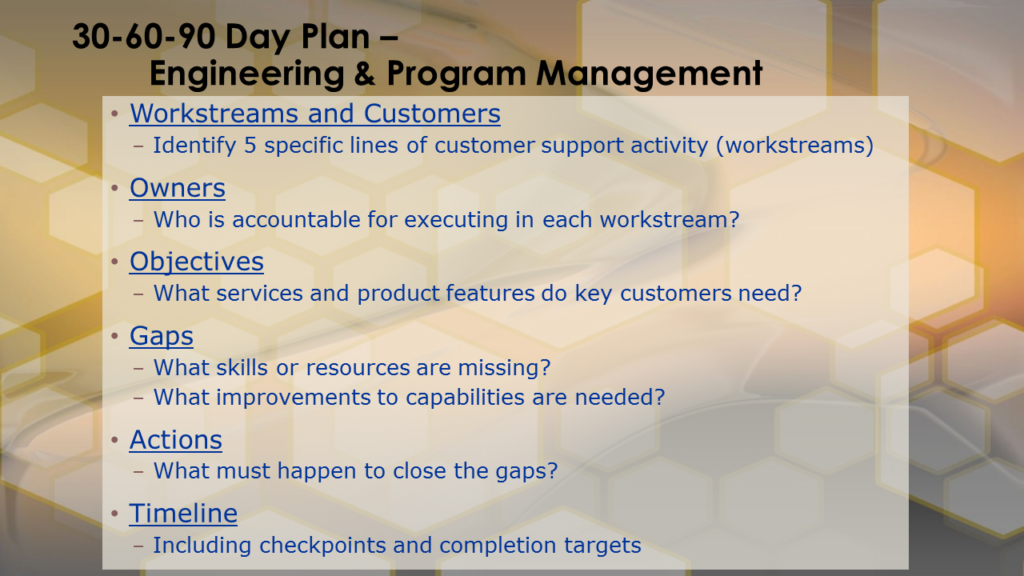The 30-60-90 Day Plan, Part Deux
Use this strategic planning method to bring individual managers together, structure their functional or project plan, and begin to form a high-performing team.
by Dann Gustavson

It’s the 21st century, it’s corporate America, and we have been re-orged again. A newly appointed director in the company reorganized the division’s Engineering and Program Management team and proposed that we align ourselves by developing what he calls a 30-60-90 Day Plan (déjà vu!) for achieving operational excellence.
We are split between two US sites that are 1,500 miles and 2 time zones apart, and responsible for 2 international operations as well, so we obviously need to establish how we will work together in support of the company’s overall goals.
Our director set a few broad objectives for us, and outlined his preferred 30-60-90 strategic planning method for us to follow, to ensure that the strategy we developed would be consistent with his own objectives, and those of the VP of R&D (his boss).
Though none of us had reported to the director previously, he did know all of us from some past projects in which we had crossed paths.
The 30-60-90 Strategic Planning Method
The managers – four of us – convened several times over about four weeks (without the director except for a few checkpoints) and assessed our new organization relative to five major workflows. We found our director’s 30-60-90 strategic planning method to be an effective framework for working through individual and team objectives.
Our result was a formal Plan similar to the structure Frank, my early-career manager, had modeled with me so many years before. Though our effort this time was for a functional business unit, the technique can work for a newly-formed project team as well.
The key focus for us was to be sure we properly identified the value streams in which our organization contributed to the overall R&D and business. Each value stream, or workstream, focused on one major subset of our customer base in the health care marketplace.
The actual plan was finalized and presented in a set of about 20 PowerPoint slides. The slides were the culmination of 100 or more person-hours of work – research, interviews with customers and stakeholders, debates about scope, skills, and schedules.
We overcame considerable ‘cognitive dissonance’ among the managers who had different perspectives, and finally wordsmithed the message we would deliver. Key elements of the Plan are shown in the accompanying chart.

The director probed, prodded, cajoled, and asked tough questions to be sure we had thoroughly analyzed what we were presenting. After 90 minutes or so he was satisfied and accepted our Plan, capping off with a celebratory cup of coffee for all.
We implemented it pretty much as conceived over the next several months, measuring ourselves at the 30-60-90 day milestones and beyond.
OK, Dann – What’s My Take-away?
Whether you’re dealing with a new project team or a new functional organization, it is important to ensure the team members (who may or may not already know each other) rapidly develop the ability to work together and trust each other.
A 3-day kum-ba-ya retreat at a golf or beach resort may be a great way to do that, but budget reality usually intrudes and we settle for a few lunch meetings in an out-of-the-way conference room.
Kick off the plan by setting the overall scope and objectives to be achieved by the team, then guide them through a focused planning exercise. The use of short, medium, and longer term goals, exemplified by the 30-60-90 day structure, can help the team leaders weigh decisions in light of complexity and risk.
Give the team broad leeway to determine how each member’s skills and abilities can be applied in the project or business unit.
Enabling the team to create their own plan means the team leaders will own the goals and be far more committed than if they have something handed down from on high, with no team input considered, and no context from the powers that be.
In other words, behaving yourself into Next Level Leadership!
Dann Gustavson, PMP®, Lean Six-Sigma Black Belt, helps Program Managers and their teams achieve superior results through high-impact program execution. Prepare, structure, and run successful programs in product engineering, manufacturing operations (including outsourcing), and cross-functional change initiatives.
Contact Dann@Lean6SigmaPM.com.
